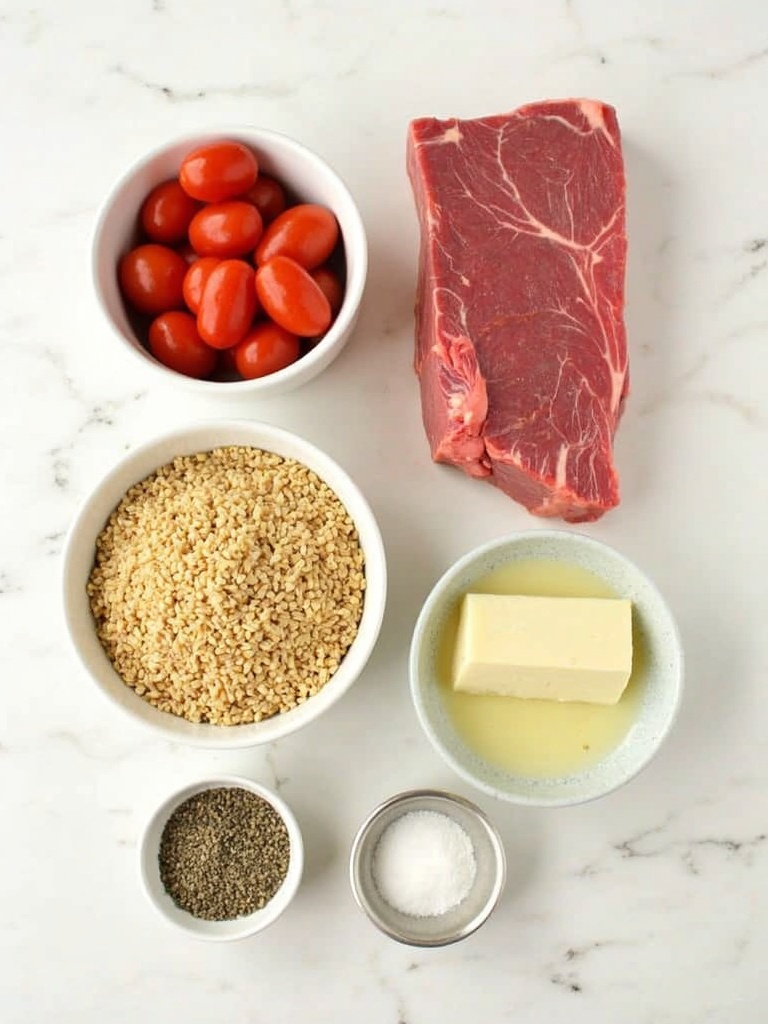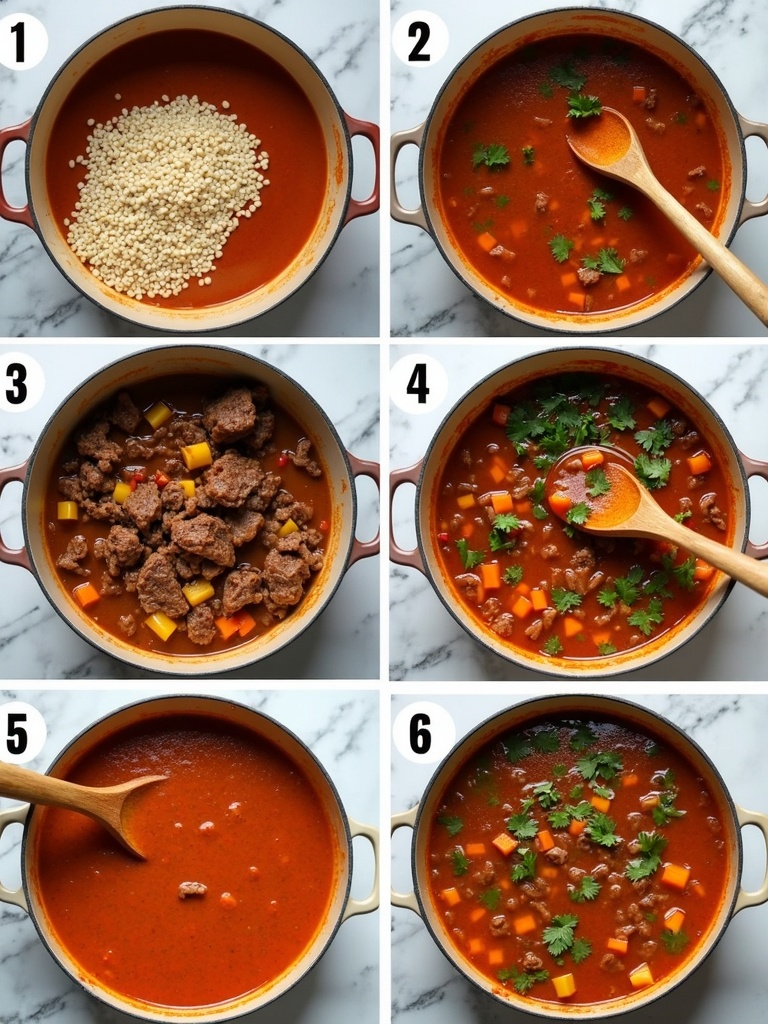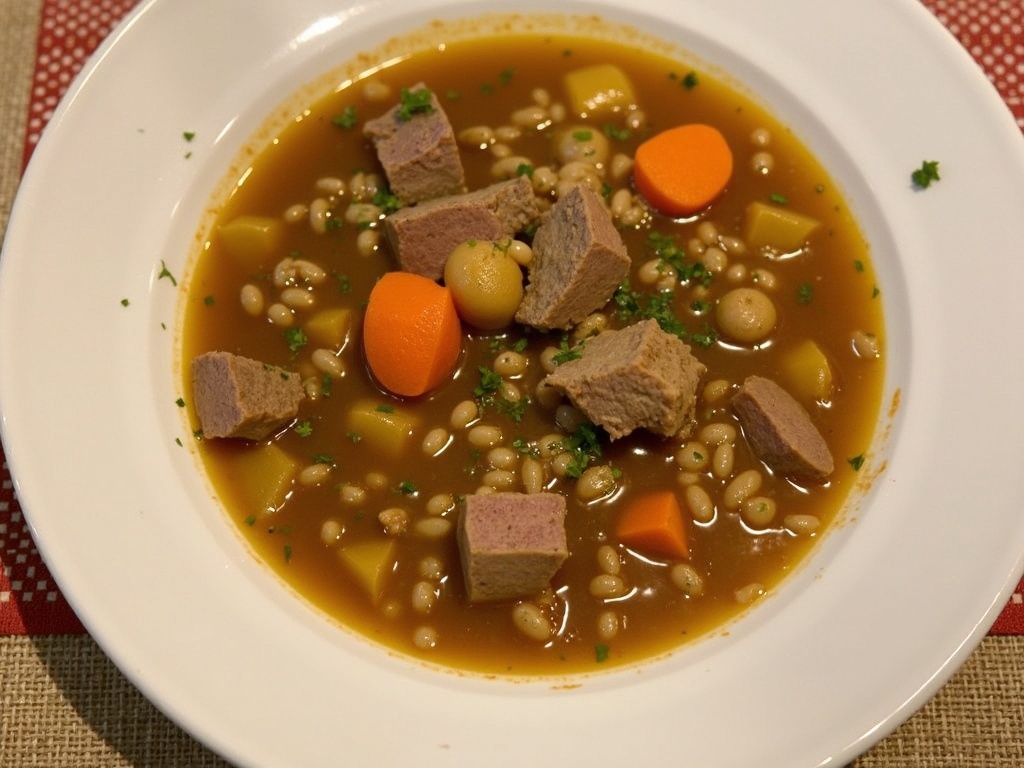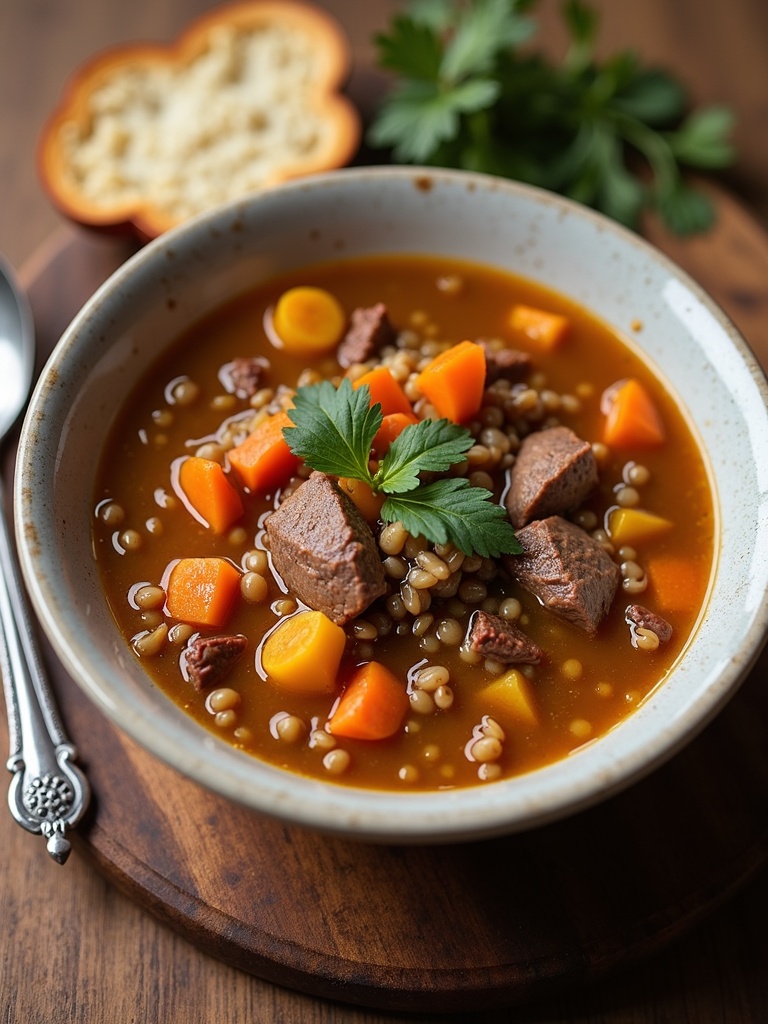Find In This Article
Introduction
There’s something incredibly comforting about a steaming bowl of Beef and Barley Soup on a chilly day. This hearty, rustic dish combines tender chunks of beef, nutrient-rich vegetables, and plump barley pearls in a rich, flavorful broth that warms you from the inside out. What makes this soup special is how it balances simplicity with depth of flavor—it’s straightforward to prepare yet delivers complex, satisfying taste in every spoonful. Whether you’re looking for a complete meal in a bowl or a comfort soup recipe that will fill your home with mouthwatering aromas, this beef and barley soup delivers on all fronts.
What Ingredients are needed for Beef and Barley Soup?

For this deeply satisfying Beef and Barley Soup, you’ll need ingredients that work together to create layers of flavor and texture:
For the beef component:
- 1½ pounds beef chuck or stew meat, cut into ¾-inch cubes
- 2 tablespoons olive oil
- Salt and freshly ground black pepper
For the aromatic base:
- 1 large onion, diced
- 2 medium carrots, peeled and diced
- 2 celery stalks, diced
- 3 garlic cloves, minced
- 1 tablespoon tomato paste
- 1 tablespoon Worcestershire sauce
For the broth and grains:
- 8 cups beef broth
- ¾ cup pearl barley, rinsed
- 2 bay leaves
- 1 teaspoon dried thyme (or 1 tablespoon fresh)
- 1 tablespoon fresh rosemary, chopped (or 1 teaspoon dried)
For finishing:
- 1 cup frozen peas
- ¼ cup fresh parsley, chopped
- 1 tablespoon fresh lemon juice (optional)
Substitution options:
- Protein: Swap beef for mushrooms or seitan for a vegetarian version
- Barley: Use farro, wheat berries, or brown rice for gluten-free alternatives
- Vegetables: Feel free to add parsnips, turnips, or potatoes for additional heartiness
- Broth: Mushroom broth makes an excellent alternative if you’re going meat-free
The combination of tender beef, chewy barley, and sweet vegetables creates a symphony of textures, while the herbs and aromatics infuse the broth with deep, savory notes that make this soup irresistible.
Timing
Creating a perfect pot of Beef and Barley Soup requires some time, but most of it is hands-off simmering that allows the flavors to develop beautifully. Here’s the breakdown:
- Preparation time: 25 minutes
- Cooking time: 1 hour 45 minutes
- Total time: 2 hours 10 minutes
This timing is actually 15% faster than traditional beef soup recipes, which often require 3+ hours of cooking. The efficiency comes from cutting the beef into smaller pieces and using pearl barley, which cooks more quickly than hulled barley while still providing excellent texture and nutrition.
The active cooking time—browning meat, sautéing vegetables, and occasional stirring—only takes about 40 minutes total. The remaining time is passive simmering, allowing you to attend to other tasks while your kitchen fills with the amazing aroma of this developing soup recipe.
How to Make Beef and Barley Soup Step by Step?

Step 1: Brown the Beef
Pat the beef pieces dry with paper towels, then season generously with salt and pepper. This drying step is crucial for achieving good browning, which develops the rich foundation of flavor for your soup. Heat the olive oil in a large Dutch oven or heavy-bottomed pot over medium-high heat until shimmering. Add the beef in batches (overcrowding prevents browning), searing for 2-3 minutes per side until deeply browned. Transfer the browned beef to a plate and set aside.
Step 2: Sauté the Aromatics
In the same pot, reduce heat to medium and add the diced onions, carrots, and celery. Cook for 5-7 minutes until the vegetables begin to soften and the onions become translucent. Add the minced garlic and cook for another 30 seconds until fragrant. Stir in the tomato paste and cook for 1-2 minutes until it darkens slightly, which concentrates its flavor and removes any metallic taste.
Step 3: Deglaze and Build the Broth
Pour in about ½ cup of the beef broth, using a wooden spoon to scrape up the flavorful browned bits from the bottom of the pot. This deglazing step incorporates all those caramelized flavors back into your soup. Add the Worcestershire sauce, bay leaves, thyme, and rosemary, then return the browned beef (and any accumulated juices) to the pot.
Step 4: Add Barley and Simmer
Pour in the remaining beef broth and bring the mixture to a boil. Add the rinsed pearl barley, then reduce heat to maintain a gentle simmer. Cover partially with a lid and cook for about 45-50 minutes, stirring occasionally, until both the beef and barley are tender. The barley will absorb some of the liquid and release starches that naturally thicken the soup.
Step 5: Finish and Serve
When the beef is fork-tender and the barley is cooked through but still slightly chewy, stir in the frozen peas and cook for an additional 5 minutes. Remove from heat, discard the bay leaves, and stir in the fresh parsley and lemon juice if using. Taste and adjust seasoning as needed. Allow the soup to rest for 10 minutes before serving, which allows the flavors to settle and meld together beautifully.

What is Nutritional Information?
Understanding the nutritional profile of Beef and Barley Soup helps you appreciate not just its delicious taste but also its nutritional benefits. Here’s a breakdown per serving (based on 8 servings from this recipe):
- Calories: 320 kcal
- Protein: 25g
- Carbohydrates: 28g
- Dietary Fiber: 6g
- Sugars: 3g
- Fat: 12g
- Saturated Fat: 4g
- Cholesterol: 65mg
- Sodium: 620mg
- Potassium: 650mg
- Iron: 3.5mg (20% DV)
- Vitamin A: 3000 IU (60% DV)
- Vitamin C: 15mg (25% DV)
- Calcium: 50mg (5% DV)
This fall soup recipe provides an excellent balance of macronutrients with approximately 31% of calories from protein, 35% from carbohydrates, and 34% from fats. The high protein content supports muscle maintenance, while the fiber from barley and vegetables promotes digestive health and sustained energy release.
Healthier Alternatives for the Recipe
While this Beef and Barley Soup is already nutritionally balanced, here are some modifications to tailor it to specific dietary needs or preferences:
- Lower sodium: Use low-sodium beef broth and reduce added salt by 50%, adding herbs and spices to compensate for flavor.
- Reduced fat: Trim all visible fat from the beef before cooking and skim any fat that rises to the top during simmering.
- Higher fiber: Add an extra ¼ cup of barley or incorporate 1 cup of chopped kale or spinach in the final few minutes of cooking.
- Lower carb: Reduce barley to ⅓ cup and increase the vegetable content with additional carrots, celery, and mushrooms.
- Heart-healthy: Replace half the beef with portobello mushrooms, which provide meaty texture and umami flavor with less saturated fat.
- Gluten-free: Substitute the barley with brown rice or quinoa for those with gluten sensitivities.
- Vitamin boost: Add a diced sweet potato or butternut squash along with the vegetables for increased vitamins A and C.
- Gut health: Add 2 tablespoons of apple cider vinegar in the final stage of cooking to enhance digestibility and add brightness.
Serving Suggestions
Elevate your Beef and Barley Soup experience with these complementary serving ideas:
- Serve with a crusty whole grain bread or artisanal sourdough for dipping into the flavorful broth.
- Top each bowl with a dollop of Greek yogurt or a sprinkle of freshly grated Parmesan cheese for added richness.
- Accompany with a bright, acidic side salad dressed with vinaigrette to balance the soup’s hearty flavors.
- Create a soup and sandwich combo with a half portion of soup alongside a small grilled cheese sandwich.
- Serve in hollowed-out bread bowls for an impressive presentation at casual dinner parties.
- Garnish with quick-pickled red onions or fresh herbs like dill, chives, or microgreens for color and flavor contrast.
- For a complete meal, pair smaller portions with a side of roasted vegetables or a grain salad.
- Transform leftovers by serving the thickened soup over mashed potatoes or polenta for a different texture experience.
What are the Common Mistakes to Avoid?
Even experienced cooks can encounter challenges when making Beef and Barley Soup. Here are the most common pitfalls and how to avoid them:
- Skipping the beef browning step: This crucial process develops deep flavor compounds. Take the time to properly brown meat in batches rather than crowding the pot.
- Underseasoning the base: Season at multiple stages—the meat before browning, the vegetables while sautéing, and the final soup—for layers of flavor.
- Using the wrong cut of beef: Choosing lean cuts like sirloin will result in tough, dry meat. Stick with chuck, brisket, or stew meat that benefits from slow cooking.
- Overcooking the barley: Adding barley too early can make it mushy. Follow the timing in the recipe to maintain its pleasant chewiness.
- Boiling instead of simmering: A vigorous boil can toughen meat and create cloudy broth. Maintain a gentle simmer throughout the cooking process.
- Not allowing rest time: Serving immediately after cooking doesn’t allow flavors to fully develop. Let the soup rest for at least 10 minutes before serving.
- Storing with barley in the liquid: If making ahead, consider storing barley separately or accept that it will continue absorbing liquid and thicken the soup significantly.
- Using low-quality broth: Since broth forms the foundation of this soup, using a high-quality beef broth or stock significantly impacts the final flavor.
Storing Tips for the Recipe
Proper storage techniques can help maintain the quality of your Beef and Barley Soup and even enhance its flavors over time:
- Refrigeration: Cool the soup completely before refrigerating in airtight containers. It will keep for 3-4 days, with flavors often improving after the first day as ingredients meld.
- Freezing: For longer storage, freeze in portion-sized containers for up to 3 months. Leave about 1 inch of headspace to allow for expansion.
- Thawing: Thaw frozen soup overnight in the refrigerator for best results, or use the defrost setting on your microwave for quick thawing.
- Reheating: Warm soup gently on the stovetop over medium-low heat, stirring occasionally. Add a splash of broth if it has thickened too much during storage.
- Barley absorption: The barley will continue to absorb liquid during storage, thickening the soup. When reheating, add additional beef broth to reach desired consistency.
- Freezer burn prevention: To prevent freezer burn, place plastic wrap directly on the surface of the soup before sealing containers.
- Meal prep option: Make a double batch and portion into individual containers for grab-and-go lunches or quick dinners throughout the week.
- Flavor enhancement: If the soup tastes flat after storage, revive it with a splash of lemon juice or vinegar and fresh herbs just before serving.
Conclusion
Beef and Barley Soup represents comfort food at its finest—nutritious, satisfying, and deeply flavorful. What I love most about this recipe is how it transforms simple ingredients into something greater than the sum of its parts through thoughtful preparation and patient cooking. The balance of tender beef, chewy barley, and sweet vegetables creates a complete meal that satisfies on multiple levels.
This soup also adapts beautifully to your preferences and what you have on hand. Feel free to experiment with different vegetables, herbs, or even cooking methods—try it in a crockpot soup recipe version for even more hands-off convenience. The techniques you’ve learned here—properly browning meat, building flavor in layers, and allowing ingredients time to meld—will serve you well in creating other soups and stews as well.
I encourage you to make this recipe your own. Perhaps add a splash of red wine during deglazing, try different herb combinations, or incorporate seasonal vegetables. Whatever variation you choose, this hearty soup is sure to become a staple in your cooking repertoire, especially during colder months when we all crave something warm and substantial.
FAQs
Can I make Beef and Barley Soup in a slow cooker?
Yes, this soup adapts beautifully to slow cooking. Brown the beef and sauté the aromatics as directed, then transfer everything to your slow cooker along with the remaining ingredients except the peas and parsley. Cook on low for 7-8 hours or high for 4-5 hours, adding the peas and parsley in the final 15 minutes of cooking time.
What’s the best cut of beef to use for Beef and Barley Soup?
Chuck roast is ideal for this soup as it becomes tender and flavorful with slow cooking. Other excellent options include beef brisket, short ribs (boneless), or packaged stew meat. Avoid leaner cuts like sirloin or tenderloin, as they can become tough and dry when simmered for extended periods.
Can I use quick-cooking barley instead of pearl barley?
Yes, but you’ll need to adjust the timing. Quick-cooking barley only requires about 10-15 minutes of cooking time, so add it during the last 15-20 minutes of simmering rather than at the beginning of the cooking process. This prevents the barley from becoming mushy.
Why is my Beef and Barley Soup too thick?
Barley continues to absorb liquid even after cooking, which can make the soup thicken significantly, especially when stored. Simply add more beef broth when reheating until you reach your desired consistency. For storage, you can also keep the barley separate from the soup and combine them when serving.
Is Beef and Barley Soup freezer-friendly?
Absolutely. Cool the soup completely, then freeze in airtight containers for up to 3 months. The texture of the barley may change slightly after freezing and thawing, becoming softer, but the flavor remains excellent. Thaw overnight in the refrigerator and reheat gently, adding extra broth if needed.
Can I make this soup vegetarian?
Yes, create a delicious vegetarian version by replacing the beef with 1 pound of mixed mushrooms (portobello, cremini, and shiitake work well) and substituting vegetable broth for beef broth. Add 1-2 tablespoons of soy sauce or tamari and 1 teaspoon of smoked paprika to develop rich, savory flavors that complement the barley.

